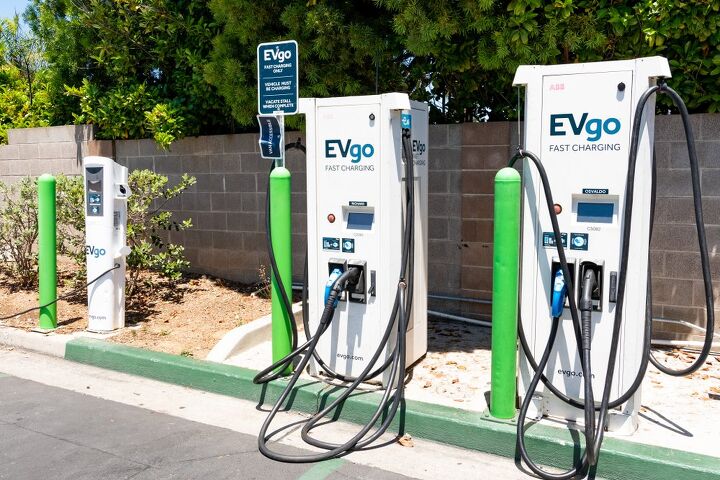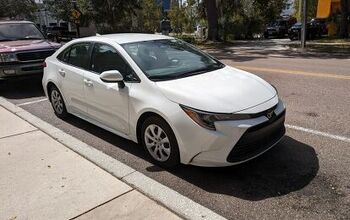Study: America Allegedly Needs to Quadruple EV Chargers by 2025

The United States is in the midst of expanding its electric vehicle charging network to ensure there’s sufficient charging capacity for the planned deluge of EV sales. Companies are even getting government money earmarked within the so-called Inflation Reduction Act to ensure that the Biden administration’s lofty environmental goals are maintained. However, a recent report by S&P Global Mobility has suggested the U.S. is nowhere near on pace to meet projected EV demand.
Presently, there are roughly 163,000 places to charge an electric vehicle within the United States. According to S&P Global, that figure encompasses all public, private, standardized, and proprietary charging points that are Level 2 or higher. An estimated 64,000 of those were installed within the last twelve months, showcasing just how much headway has been made. But the report claims this will still be an insufficient pace.
By 2025, S&P Global Mobility estimates America will have up to 7.8 million EVs on the road – with electric cars making up 40 percent of the U.S. market by 2030. That’s 28.3 million vehicles, all of which will need to be powered up on a regular basis. The report suggests the nation will need to quadruple the number of chargers it currently has to meet future demand even in the short term – and that's with home charging solutions already doing a lot of the heavy lifting.
“To support that vehicle population, we expect there will need to be about 700,000 Level 2 and 70,000 Level 3 chargers deployed, including both public and restricted-use facilities,” explains the report. “By 2027, we expect there will be a need for about 1.2 million Level 2 chargers and 109,000 Level 3 chargers deployed nationally. Looking further to 2030, with the assumption of 28.3 million units EVs on US roads, an estimated total of 2.13 million Level 2 and 172,000 Level 3 public chargers will be required – all in addition to the units that consumers put in their own garages.”
Based on the current installation rate of EV chargers, those numbers seem untenable. Though the report states that EV charging probably has to become ubiquitous (and more convenient than using liquid fuels) if the projected adoption rates are even to happen.
“For mass-market acceptance of BEVs to take hold, the recharging infrastructure must do more than keep pace with EV sales,” said Graham Evans, S&P Global Mobility’s research and analysis director. “It must surprise and delight vehicle owners who will be new to electrification, so that the process seems seamless and perhaps even more convenient than their experience with gasoline refueling, with minimal compromise on the vehicle ownership experience. Developments in battery technology, and how quickly EVs can receive power, will be as critical to improvements here as how quickly and plentifully infrastructure can provide the power.”
Another big hurdle for EV adoption is the lopsided manner in which they’re being embraced. While electric transportation may be on the cusp of becoming commonplace in the wealthy suburbs of major metropolitan areas, EVs aren’t terribly popular in regions where the average driving distances tend to be longer, incomes are comparatively modest, and fewer people have garages in which to store their vehicles.
While this also influences how hungry local populations are to see additional charging points installed, the report suggested this could be offset by government policy and noted that states taking advantage of federal assistance under the Infrastructure Investment and Jobs Act (often called the “Bipartisan Infrastructure Law”) would be better positioned to meet the assumed increase in demand. Despite the legislation’s supposed focus on maintaining infrastructure, a meaningful portion is devoted toward promoting electrification and renewable energy options – earmarking $7.5 billion just to build more EV charging points.
The report claims government support will be a major factor in determining how quickly EVs are adopted, adding that states pushing zero-emission vehicle rules that would eventually ban combustion-engine cars are on track for higher adoption rates. Though that shouldn’t be much of a surprise when alternative transportation options are being eliminated.
“In states following the California Air Resources Board’s path to zero-emissions vehicle (ZEV) sales, the faster growth of consumer demand will push private investment and more rapid charging infrastructure deployment. However, in states where EV adoption happens gradually, charging station deployment will not need to happen as rapidly and may also need a bit of a push.”
Where’s that push supposed to come from? Public-private investments – which brings us to the most important thing S&P Global Mobility isn’t saying.
Despite battery electric vehicles having a sizable fanbase, the main reason you see so much media about electrification is that multinational corporations know it appeases surface-level environmentalists and is guaranteed to be accompanied by government funding. By constantly messaging about sustainability, equity, and environmental justice, the world’s largest companies can promote a squeaky-clean image that may not be representative of reality. Some companies (e.g. automakers and energy providers) can likewise benefit from pushing electrification because it affords them the opportunity to capitalize on juicy subsidies while launching new product lines that will be promoted as tomorrow’s default hardware.
Businesses aren’t necessarily running with electrification because there’s irrefutable evidence that it’ll clean up the environment or even that the world is ready to make the transition. While plenty believe earnestly in the cause, others are simply trying to predict which way the wind is about to blow. This also explains why there are vast disparities between manufacturers and markets.
German automakers have broadly committed themselves to transition toward all-electric vehicles as quickly as possible. But Japanese brands (especially Toyota) have been more skeptical and are hedging their bets in terms of future products. This is primarily influenced by the policies of their biggest markets, which technologies they’re already using, and where their executives live. The European Union has committed itself to banning internal combustion vehicles by 2035, whereas Japan is mainly concerned with lowering national emission levels via a mixed-energy approach.
However, nobody is subbing electrification entirely because there’s just too much money on the table to ignore. Whether or not you believe electrification has the potential to lessen humanity’s environmental impact, the fact remains that there’s an immense amount of social pressure behind the movement. But the relevant actors don’t appear to be taking a wholly serious approach. S&P Global may be framing its report as recommending how many chargers need to be built in order to maintain demand. But it could just as easily be a dive into the sizable headwinds EVs are still facing and the inorganic manner in which various industries and the government are trying to force the issue. If nothing but the complete and total commitment of an entire nation will be required for groups to reach their electrification goals, then the plan may have already failed.
That said, the report is loaded with information and can be used to argue whatever side you prefer. The full document is worth a read, even if you don’t agree with the overarching premise.
[Images: Sundry Photography/Shutterstock; S&P Global]
Become a TTAC insider. Get the latest news, features, TTAC takes, and everything else that gets to the truth about cars first by subscribing to our newsletter.

A staunch consumer advocate tracking industry trends and regulation. Before joining TTAC, Matt spent a decade working for marketing and research firms based in NYC. Clients included several of the world’s largest automakers, global tire brands, and aftermarket part suppliers. Dissatisfied with the corporate world and resentful of having to wear suits everyday, he pivoted to writing about cars. Since then, that man has become an ardent supporter of the right-to-repair movement, been interviewed on the auto industry by national radio broadcasts, driven more rental cars than anyone ever should, participated in amateur rallying events, and received the requisite minimum training as sanctioned by the SCCA. Handy with a wrench, Matt grew up surrounded by Detroit auto workers and managed to get a pizza delivery job before he was legally eligible. He later found himself driving box trucks through Manhattan, guaranteeing future sympathy for actual truckers. He continues to conduct research pertaining to the automotive sector as an independent contractor and has since moved back to his native Michigan, closer to where the cars are born. A contrarian, Matt claims to prefer understeer — stating that front and all-wheel drive vehicles cater best to his driving style.
More by Matt Posky
Latest Car Reviews
Read moreLatest Product Reviews
Read moreRecent Comments
- ToolGuy Why would they change the grille?
- Oberkanone Nissan proved it can skillfully put new frosting on an old cake with Frontier and Z. Yet, Nissan dealers are so broken they are not good at selling the Frontier. Z production is so minimal I've yet to see one. Could Nissan boost sales? Sure. I've heard Nissan plans to regain share at the low end of the market. Kicks, Versa and lower priced trims of their mainstream SUV's. I just don't see dealerships being motivated to support this effort. Nissan is just about as exciting and compelling as a CVT.
- ToolGuy Anyone who knows, is this the (preliminary) work of the Ford Skunk Works?
- Kwik_Shift_Pro4X I will drive my Frontier into the ground, but for a daily, I'd go with a perfectly fine Versa SR or Mazda3.
- Zerofoo The green arguments for EVs here are interesting...lithium, cobalt and nickel mines are some of the most polluting things on this planet - even more so when they are operated in 3rd world countries.




































Comments
Join the conversation
Man made climate change will go down as the biggest fraud in human history. Weeks after 41 froze to death in the Buffalo storm the idiot NY lib governor says gas furnaces and stoves will be banned by 2030 for new builds. She wants to ban wood fired stoves as well despite the abundance of timber in the state. Dozens of power plants have been demolished or disassembled and shipped to China in the last few years. All around the state forest and farm fields are being destroyed to build solar fields that will some day become superfund cleanup sites when the subsidies end and the toxic materials leach into the ground and water. All of this to transfer money from the poor and working class to the rich. Please tell me again why nobody cares that these same shysters were predicting a man made ice age just a few decades ago?
Vulpine, I'm not making an argument - just quoting what the gas company said. I don't agree with the conclusions of the letter, esp since it arrived 48 hrs before the bill arrived. We all know why the gas prices have spiked. It has little to do with cold snaps and much more to do with UKR and Euro fuel.